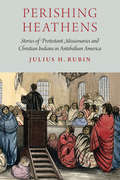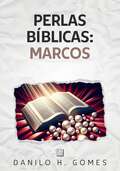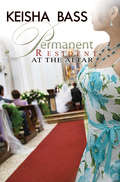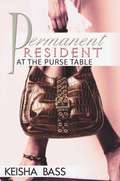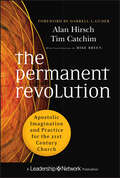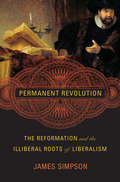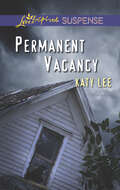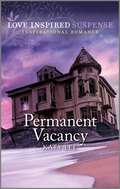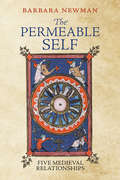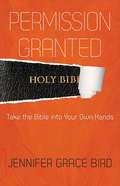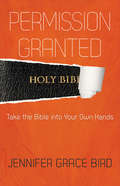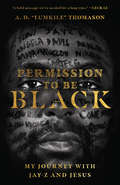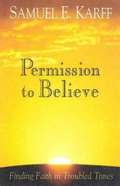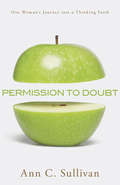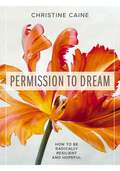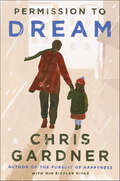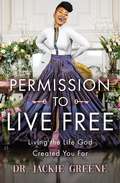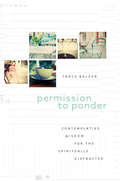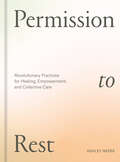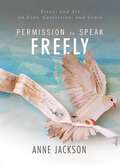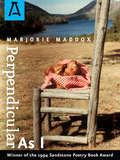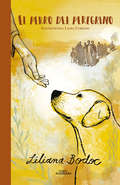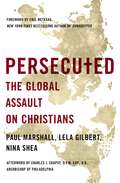- Table View
- List View
Perishing Heathens: Stories of Protestant Missionaries and Christian Indians in Antebellum America
by Julius H. RubinIn Perishing Heathens Julius H. Rubin tells the stories of missionary men and women who between 1800 and 1830 responded to the call to save Native peoples through missions, especially the Osages in the Arkansas Territory, Cherokees in Tennessee and Georgia, and Ojibwe peoples in the Michigan Territory. Rubin also recounts the lives of Native converts, many of whom were from mixed-blood métis families and were attracted to the benefits of education, literacy, and conversion. During the Second Great Awakening, Protestant denominations embraced a complex set of values, ideas, and institutions known as “the missionary spirit.” These missionaries fervently believed they would build the kingdom of God in America by converting Native Americans in the Trans-Appalachian and Trans-Mississippi West. Perishing Heathens explores the theology and institutions that characterized the missionary spirit and the early missions such as the Union Mission to the Osages, and the Brainerd Mission to the Cherokees, and the Moravian Springplace Mission to the Cherokees. Through a magnificent array of primary sources, Perishing Heathens reconstructs the millennial ideals of fervent true believers as they confronted a host of impediments to success: endemic malaria and infectious illness, Native resistance to the gospel message, and intertribal warfare in the context of the removal of eastern tribes to the Indian frontier.
Perlas bíblicas: Marcos
by Danilo H. Gomes¿Te ha resultado aburrido leer la Biblia? Entonces las cosas cambiarán a partir de ahora. Imagínate ahora varios tesoros profundos que te cambiarán la vida en unas cuantas páginas. Esta es la colección "Perlas bíblicas", porque reúne puntos importantes que probablemente han pasado desapercibidos ante tus ojos durante tus lecturas bíblicas. No se trata de secretos ocultos ni de interpretaciones extravagantes, sino de significados que te harán preguntarte "¿cómo no me di cuenta de esto antes?". Descubre verdades necesarias e interesantes a través de esta sencilla lectura. Las perlas de esta edición están tomadas del libro de Marcos.
Permanent Resident at the Altar
by Keisha BassIf Ava has to wear her fake smile one more time while standing in a wedding party, she might come unglued. She and her boyfriend, Kevin, have been seriously dating for a year. As she approaches the marriage-ripe age of thirty-one, she can't help but count down the days until her wedding day. It seems like everyone in her immediate world is getting hitched but her: cousin, friend, and even a co-worker who is shacking up while Ava's trying to live life on the straight and narrow.Kevin is the man of her dreams, but his mother doesn't believe Ava is the woman of his. Two of his sisters seem to be on the same page with their mother, treating her like an outcast every chance they get. Ava's only ally in Kevin's world is his baby sister, Tweet, a drug addict who takes up a lot of his time. Trusting God is all Ava can do as she hopes for the best, but if Ava and Kevin are meant for each other, then why is it such a struggle to get down the aisle? What's wrong with Ava? What's wrong with Kevin? Or is Kevin's mother the one calling the shots?
Permanent Resident at the Purse Table
by Keisha BassIf you're a size six, you dance. If you're Ava Alexander, you watch the purses while your girlfriends dance. Each man that passes her by takes a little of her self-esteem. After escaping a mentally abusive relationship, she promises God she will wait on Him to bring her the right man. And she means it--until Ishmael. When her best friend's fiancé throws a few compliments her way, she travels down the path of betrayal. Ava's choice strains her friendship and sends her into a depression.Ava seeks spiritual guidance from Dr. Glory Moses. Through God's Word, there is a glimpse of hope for a restored friendship, and a newfound love for the woman she is. In addition, a man she meets at the counseling center offers her a glimpse of what could be if she lines up with God's will for her life. Will Ava be able to overcome her insecurities and step into the life God plans for her, or will she continue to self-destruct?
The Permanent Revolution
by Alan Hirsch Darrell L. Guder Tim Catchim Mike BreenA new brand of apostolic ministry for today's world The Permanent Revolution is a work of theological re-imagination and re-construction that draws from biblical studies, theology, organizational theory, leadership studies, and key social sciences. The book elaborates on the apostolic role rooted in the five-fold ministry from Ephesians 4 (apostles, prophets, evangelists, shepherds, and teacher), and its significance for the missional movement. It explores how the apostolic ministry facilitates ongoing renewal in the life of the church and focuses on leadership in relation to missional innovation and entrepreneurship.The authors examine the nature of organization as reframed through the lens of apostolic ministry.Shows how to view the world through a biblical perspective and continue the "permanent revolution" that Jesus startedOutlines the essential characteristics of apostolic movement and how to restructure the church and ministry to be more consistent with themAlan Hirsch is a leading voice in the missional movement of the Christian West This groundbreaking book integrates theology, sociology, and leadership to further define the apostolic movement.
Permanent Revolution: The Reformation and the Illiberal Roots of Liberalism
by James SimpsonHow did the English Reformation, with its illiberal, intolerant beginnings, lay the groundwork for the Enlightenment—free will, liberty of conscience, religious toleration, constitutionalism, and all the rest? In his provocative rewriting of the history of liberalism, James Simpson uncovers its unexpected debt to Protestant evangelicalism.
Permanent Vacancy (Stepping Stones Island)
by Katy LeeBUYER BEWARE When Gretchen Bauer begins renovating an old Victorian house to turn it into a bed-and-breakfast, she barely escapes several dangerous "accidents" at her home. Colm McCrae, host of the home improvement TV show helping her renovate, refuses to believe these aren't on purpose. Could this be a harmful ploy by his boss to boost ratings? Yet with Colm's Irish brogue and handsome face, Gretchen wonders whether he could be involved. But with a whole town full of neighbors disgruntled about the inn bringing strangers to their shores, Gretchen has a list of more likely suspects. Now she must trust Colm if she wants to keep her new business venture from turning into a five-star death trap.
Permanent Vacancy: A Thrilling Suspense Novel
by Katy LeeDanger on her doorstep…Can she survive an unknown threat?When Gretchen Bauer begins renovating an old Victorian house, she barely escapes several dangerous &“accidents.&” But Colm McCrae, host of the home improvement TV show helping her renovate, refuses to believe these aren&’t on purpose. With a whole town full of neighbors disgruntled about the prospective inn bringing strangers to their shores, Gretchen has a long list of likely suspects. Can she trust Colm to keep her safe…before her Bed and Breakfast turns into a five-star deathtrap?From Love Inspired Suspense: Courage. Danger. Faith.
The Permeable Self: Five Medieval Relationships (The Middle Ages Series)
by Barbara NewmanHow, Barbara Newman asks, did the myth of the separable heart take such a firm hold in the Middle Ages, from lovers exchanging hearts with one another to mystics exchanging hearts with Jesus? What special traits gave both saints and demoniacs their ability to read minds? Why were mothers who died in childbirth buried in unconsecrated ground? Each of these phenomena, as diverse as they are, offers evidence for a distinctive medieval idea of the person in sharp contrast to that of the modern "subject" of "individual."Starting from the premise that the medieval self was more permeable than its modern counterpart, Newman explores the ways in which the self's porous boundaries admitted openness to penetration by divine and demonic spirits and even by other human beings. She takes up the idea of "coinherence," a state familiarly expressed in the amorous and devotional formula "I in you and you in me," to consider the theory and practice of exchanging the self with others in five relational contexts of increasing intimacy. Moving from the outside in, her chapters deal with charismatic teachers and their students, mind-reading saints and their penitents, lovers trading hearts, pregnant mothers who metaphorically and literally carry their children within, and women and men in the throes of demonic obsession. In a provocative conclusion, she sketches some of the far-reaching consequences of this type of personhood by drawing on comparative work in cultural history, literary criticism, anthropology, psychology, and ethics.The Permeable Self offers medievalists new insight into the appeal and dangers of the erotics of pedagogy; the remarkable influence of courtly romance conventions on hagiography and mysticism; and the unexpected ways that pregnancy—often devalued in mothers—could be positively ascribed to men, virgins, and God. The half-forgotten but vital idea of coinherence is of relevance far beyond medieval studies, however, as Newman shows how it reverberates in such puzzling phenomena as telepathy, the experience of heart transplant recipients who develop relationships with their deceased donors, the phenomenon of psychoanalytic transference, even the continuities between ideas of demonic possession and contemporary understandings of obsessive-compulsive disorder.In The Permeable Self Barbara Newman once again confirms her status as one of our most brilliant and thought-provoking interpreters of the Middle Ages.
Permission Granted: Take The Bible Into Your Own Hands
by Jennifer BirdMillions of people around the world look to the Bible as a source of encouragement and faith formation, a reminder that God is love and is in control, and a guide to living one's life the way God desires. But this treasured book has also been misused and manipulated by many, placed on a pedestal of untouchability, and protected from questioning and honest engagement. In Permission Granted, Jennifer Grace Bird encourages people of faith to explore the texts on their own, freed from long-held myths and misconceptions; experience the Bible anew; and appreciate this holy book for what it is--not what we think it should be. With the sensitivity of one who has discovered this freedom herself, Bird invites readers to engage what the Bible really says about twelve key issues, including sin, sex, and the role of women.
Permission Granted: Take the Bible into Your Own Hands
by Jennifer Grace BirdMillions of people around the world look to the Bible as a source of encouragement and faith formation, a reminder that God is love and is in control, and a guide to living one's life the way God desires. But this treasured book has also been misused and manipulated by many, placed on a pedestal of untouchability, and protected from questioning and honest engagement. In Permission Granted, Jennifer Grace Bird encourages people of faith to explore the texts on their own, freed from long-held myths and misconceptions; experience the Bible anew; and appreciate this holy book for what it is--not what we think it should be. With the sensitivity of one who has discovered this freedom herself, Bird invites readers to engage what the Bible really says about twelve key issues, including sin, sex, and the role of women.
Permission Granted: Be Who You Were Made to Be and Let Go of the Rest
by Melissa Camara WilkinsFrom award-winning blogger Melissa Camara Wilkins, come and find a stunningly simple path to confidence and clarity. All you have to do is give yourself permission to show up as your gloriously imperfect self.Trying to fix yourself is exhausting. But being yourself - that is both possible and life-giving. The key is a simple heart-shift from chasing after perfection to learning to tell a truer story about ourselves, the world, and our place in it.Melissa Camara Wilkins invites you into her journey of discovering the profound simplicity of dropping the pretenses and allowing ourselves to be fully human - flaws and all. This is a story about making life simpler by letting go of who you think you're supposed to be and becoming who you really are.With wit and compassion, Melissa explores how to be present, show up as your real self, and get comfortable in your own skin by aligning the truth inside you with the life you live on the outside. Gain confidence with the freeing practices of dropping the mask, abandoning the experts, and understanding your real assignment. With refreshing honesty and insight, Melissa invites you to move from the either/or dichotomy into a spacious freedom of embracing the both/and - brave and scared, messy and real, gloriously imperfect and absolutely enough. This is your permission slip to be your whole, human self.For everyone who feels the pressure to fit in, measure up, and get it together, Permission Granted is a life-giving invitation to soul-level simplicity.
Permission to Be Black: My Journey with Jay-Z and Jesus
by A. D. ThomasonEmbracing your Christian identity does not make you "soft." Embracing your Black identity does not make you less Christian. Throughout American history, Black people were not given the freedom to acknowledge their suffering. A. D. Thomason believes that the Holy Spirit brings freedom and liberation as we're able to name our pain, recognize its roots in history and society, and seek healing. While many saw a confident, six-foot-five Black man, A. D. "Lumkile" Thomason lived most of his life in fear and anguish, deeply wounded by encounters with violence, abandonment, and family tragedy. Hiding behind a tough exterior, Adam earned his "Black card" but felt joyless inside. Even traveling around the globe to play professional basketball could not resolve his despair. But in the art of Jay-Z, A. D. discovered stirring honesty that gave voice to his own expressions of longing. And in the gospel of Jesus, he experienced the healing and salvation that had long evaded him. Now through what he calls "kingdom therapy," he's figuring out how to redefine the Jay-Z and Jesus that make up his blackness. A. D. uses his artistry as a poet and storyteller to share how he confessed his internalized pain and embraced the liberating joy of Christ. He writes for millennials, emerging adults, and anyone else who's ready to acknowledge the reality of racial trauma and our need to confront it. A. D.'s powerful story gives you permission to be Black, to be Christian, and to be the person God has made you to be.
Permission to Believe: Finding Faith in Troubled Times
by Samuel E. KarffPermission to Believe is a powerful statement of belief and faith by Samuel Karff, a prominent rabbi, spiritual leader, and outstanding figure in Jewish-Christian relations. Rabbi Karff, describing conversations he has had his entire career with agnostics, atheists, and other doubters, has been struck by the fact that "on some level my challengers wanted me to win the argument....Granting ourselves permission to believe does not require that we turn away from the 'ordinary world' but that we heed these deep intuitions of our heart....Life is not only a puzzle to solve but a mystery to embrace." The book contains 10 chapters and explores themes of brokenness, stubbornness, doubt, and faith. Chapter titles: What Is Faith? What Kind of Life Is This Anyway? Confronting the Obstacles to Faith, Recovering Faith, Prayer--The Vital Connection, Overcoming A Crisis of Faith, When Prayer Is Not Enough, The Power of Love, Living in a Broken World, Sustaining Faith in Our Later Years, Dance, Laughter, and Hope.
Permission to Doubt: One Woman's Journey into a Thinking Faith
by Ann C. SullivanAnn C. Sullivan has challenged and encouraged thousands of women as an international speaker. In her first book, Permission to Doubt, she offers a candid look at when her faith and reason collided. Through a thirteen-year struggle with an undiagnosed panic disorder, Ann learned several valuable lessons: Never shy away from the big questions. Always follow the evidence to its logical conclusion. And genuine truth doesn't buckle under the bright lights of interrogation.Ann uses these lessons to help readers recognize doubt and also shares unique step-by-step solutions in which faith can be reinforced in the midst of our struggle. Using personal examples and an intensely practical approach, Permission to Doubt informs, challenges, and encourages those who'd like to take their faith a little deeper. It's an honest look at what faith is--where it comes from, how it's threatened, and how it can be strengthened.
Permission to Dream: How to be Radically Resilient and Hopeful
by Christine CaineDo you have a dream God has put on your heart? A desire to change the world around you for the better? As you pursue those dreams and your purpose in this life, you will encounter moments where you feel unworthy, ill-equipped, or like you're not enough. And when you do, it is important to know that God is for you. The highs and lows are part of your story, but they aren't the whole story. With God's help, you can build the resilience to keep pushing forward and hold onto hope--even in the face of setbacks or obstacles.Permission to Dream by bestselling author Christine Caine will:teach you about resiliency and how to be strong despite the challenges.help you listen and tune into God's calling so you can overcome previous pain.provide you with steps on how to overcome feelings of unworthiness.teach you strategies to help you manage disappointment and maintain hope.This book is for anyone who:knows their purpose but isn't sure how to take the next step forward.questions their value.feels like they're not enough.is wondering what God has planned for them.Curated from messages shared in Unstoppable, Undaunted, and Unexpected, along with new insights and encouragement, Permission to Dream is a reminder that you are needed in this world, and you matter. Your purpose is bigger than you know, and God has created you to do something that will reflect his light in the world, and he has qualified you to do it. With his help, you can fulfill all that He's created you to do.
Permission to Dream
by Chris Gardner Mim Eichler RivasIn the spirit of The Last Lecture, The Secret, and The Alchemist, this small book presents BIG ideas for turning your “one day” into today, including the generational transfer of a dream and a powerful blueprint for a masterpiece life—from the author of the New York Times bestselling memoir and major motion picture The Pursuit of Happyness.On a winter’s day, Chris Gardner set off with his nine-year-old granddaughter Brooke to find the harmonica of her dreams. The search sends them North “beyond the wall” into a foreboding Chicago neighborhood and, soon, on a harrowing adventure that will change both of their lives—and ours. Chris is still mourning the loss of his girlfriend to brain cancer. Her question haunts him: “Now that we know how short life can be, what will you do with the time you have left?” After five years, he feels an urgency—what he calls, “Atomic Time” in which every second counts—to find an answer, but is stuck. Even while giving Brooke permission to aspire to one day become President of the United States, he knows it’s time to reclaim his own permission to dream.Lost, Chris and his granddaughter board a bus, reminding him of earlier rides through dark times when dreams of a better life kept him alive. As the two wind through a changing cityscape, Chris reflects on past lessons that offer powerful guidance for dreaming your way to monumental success. At its heart, this book lays out a blueprint for building a dream-come-true life—even during uncertainty. Gardner delivers the secrets to achieving a prosperous career—from a method for identifying your ultimate dream to a playbook for becoming world class at it. His tools include the “new 3 R’s”—or the Rep, the Rap and the Rolodex—which reveal how to earn a stellar reputation, develop a rap for marketing yourself, and amass a Rolodex of rewarding relationships. No matter how much wealth you achieve, Chris notes, true success comes from enriching the lives of others—so all can still have access to the American Dream. Toward the end, Brooke observes that in Atomic Time it’s never too late for anyone to reinvent themselves and change their fortune. Chris, hearing her, realizes what his next pursuit will be—to go back to high school and give permission to dream to the next generation of problem solvers and change makers. A true fable, Permission to Dream is a timeless and timely manifesto for turning dreams into action—beginning right now.
Permission to Live Free: Living the Life God Created You For
by Jackie GreeneGod made you to be your truest, most authentic self. He's already given you permission to live your life unapologetically--what are you waiting for? Join pastor, Bible teacher, and women's ministry leader Dr. Jackie Greene as she helps you cast off counterfeit living and finally live freely in God.After years of struggling with people-pleasing and living unauthentically, Dr. Jackie had a revelation that God had designed her precisely the way he wanted her--quirks and all. That message has changed her life, and in Permission to Live Free she wants to use it to change yours, too.Through her popular Permission Conferences, Permission World Facebook group, newly launched podcast, Permission Talk, and Dig Deep Bible studies, Dr. Jackie has already changed the lives of thousands of women who were ready to start living the life they were called to live.Permission to Live Free will give you the tools and encouragement you need to:Not change who you areNot settleStart right where you areShow up as the bold woman you were created to beIt's time to let go of what's holding you back from living in the fullness of who God uniquely designed you to be. No more counterfeit living--you were made for more! Let Dr. Jackie show you the way. Praise for Permission to Live Free:"In a world that celebrates sameness, Jackie Greene's ministry and mission untether us from fear and give us permission to be the unique individuals that God intended. Each chapter of this book will shake you awake from the doldrums of comparison and complacency and challenge you to live out your God-given design freely and fully. Instead of melding seamlessly into the mold, you'll discover the power of accepting your unique identity and then surrendering it fully to Jesus Christ. More than ever before, we need these words. And we need this work. Write on, Jackie. Write on."--Priscilla Shirer, Bible teacher and New York Times bestselling author
Permission to Ponder: Contemplative Wisdom for the Spiritually Distracted
by Tracy BalzerGod gives us permission to meditatively ponder, even in the midst of our fragmented existence. He invites us to "listen, that you may live."Many Christians are distracted and dissatisfied. The external demands of life grip us, while our inner walk with God becomes ever more superficial and thin. Is there hope for authentic connection with God in a world of distractions, or must we be resigned to a spiritually shallow existence? Reflection, contemplation, and meditation are ancient practices that are losing ground in a highly technological world. Permission to Ponder examines the ways others have accepted the invitation from God to dwell deeply, beginning with "the Four Marys" of the Gospels. In the midst of their stories, the classical discipline of lectio divina—praying the Scripture—will serve as a template for praying and pondering all of life.
Permission to Rest: Revolutionary Practices for Healing, Empowerment, and Collective Care
by Ashley NeeseA revolutionary invitation to tend to our fundamental need for renewal, self-care, and mindfulness by disengaging from our devices and acknowledging the ways that we are burnout, from the author of How to Breathe.&“Permission to Rest shows us why slowing down is so important and exactly how to do so in a way that facilitates true rest and growth. It&’s the guide we didn&’t know we so desperately needed.&”—Dr. Will Cole, functional medicine expert, and New York Times bestselling author of Intuitive Fasting and Gut FeelingsIn a culture that constantly tells us to do more of everything but simultaneously pressures us to do nothing, Permission to Rest is a passionate cry for a more regulated, resourced, and rested life. Wellness expert Ashley Neese combines personal essays, contemplative questions, scientific research, and somatic practices to help us disrupt the state of urgency, reflect inward, and relax deeply. Neese examines common beliefs around rest and offers support and guidance to challenge the shame, guilt, and discomfort that often arise when we attempt to slow down.Neese presents a series of body-focused rest practices for those who are running on empty, such as Cultivating a Rest/Work Rhythm, Nature Bathing, and Social Media Sabbatical. She addresses common roadblocks when beginning a rest practice, the incredible health benefits of prioritizing rest, and a number of holistic resources for developing a sustainable relationship to rest. The practices work for those short on time, but their benefits build the more you practice every day. Permission to Rest is both a timely manifesto and compassionate call to action. In her signature warm, grounding, and authoritative style, Neese invites each of us to pause, look inward, learn to feel our own rhythms, and value rest as a deeply healing, empowering, and spiritual practice. This book is a reminder that we have the power to transform our lives from the inside out.
Permission to Speak Freely: Essays and Art on Fear, Confession, and Grace
by Anne JacksonIn May 2008, Anne Jackson asked a question onher blog, "What is one thing you feel you can't say in church?" Hundreds responded. Everyone had a story.Permission to Speak Freely is the unique new project and movement of author AnneJackson, who is finished with keeping brokenness in the dark. Bringing to lightthe original intent of God's sanctuary as a place of help and healing, Annereveals that through confession, both to God and to others, we can live livesthat are whole and healed.Told with disarming transparency, Anne shareswhat led to her own addictions and the ensuing lifestyle that left her woundedand withdrawn, but ultimately rescued and redeemed. She includes dramaticstories of others who also learned to abandon their fear, pride, and masks; toidentify their hurts; and to find the courage to speak freely.Their confessions, submitted as mixed mediapieces, photography, and sketches, were collected from people across the world,and are included throughout the book. Readers will share in the opportunity tofind their own path to redemption and freedom.
El perro del peregrino
by Liliana BodocUna novela conmovedora sobre el hombre que cambió la historia de Occidente. Nazareth bajo el dominio de los Romanos... Un peregrino salva a un cachorro que fue arrojado a las aguas del Tiberíades. Con ayuda de la lavandera, este hombre le da un nombre: Miga de León. A partir de entonces, el perro y el peregrino van juntos: comparten el pan, la alegría y el miedo. Detrás de su padre camina Miga de León y huele el amor, la devoción y la traición de los hombres. El perro llevará al lector hasta el pie del madero, allí donde termina y comienza esta historia de un amor sin condiciones. *Nueva edición ilustrada por Laura Córdoba.
Persecuted: The Global Assault on Christians
by Paul MarshallChristians are the world's most widely persecuted religiousgroup, according to studiesby the Pew Research Center, Newsweek,and the Economist, among others.A woman is caught with a Bible and publicly shot to death.An elderly priest is abducted and never seen again. Three buses full ofstudents and teachers are struck by roadside bombs. These are not casualties ofa war. These are Christian believers being persecuted for their faith in thetwenty-first century. Many Americans do not understand that Christians today arevictims in many parts of the world. Even many Western Christians, who worshipand pray without fear of violent repercussions, are unaware that so manyfollowers of Christ live under governments and among people who are oftenopenly hostile to their faith. They think martyrdom became a rarity long ago. Persecuted soundlyrefutes these assumptions. This book offers a glimpse at the modern-day life ofChristians worldwide, recounting the ongoing attacks that rarely makeinternational headlines. As Western Christians pray for the future of Christ'schurch, it is vital that they understand a large part of the world's Christian believerslive in danger. Persecuted gives documentedaccounts of the persecution of Christians in Africa, Asia, the Middle East, andformer Soviet nations. It contains vivid stories of men and women who sufferabuse because of their faith in Jesus Christ, and tells of their perseveranceand courage.. Persecuted is far more than a thorough and moving study of this global pattern of violence--it isa cry for freedom and a call to action.
